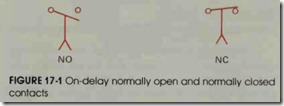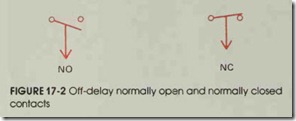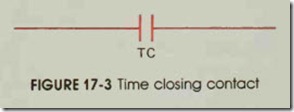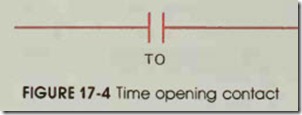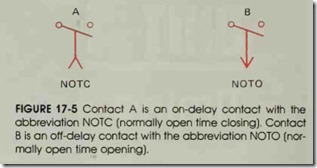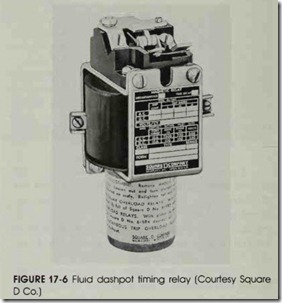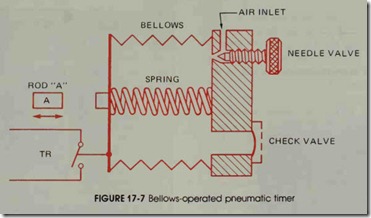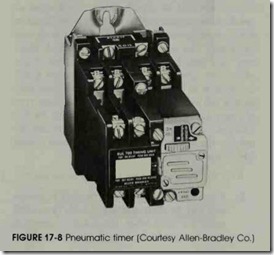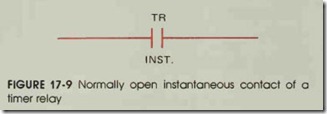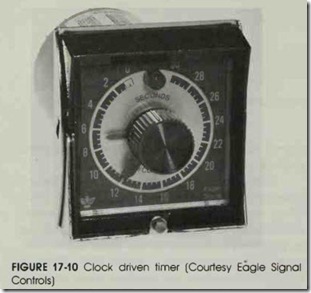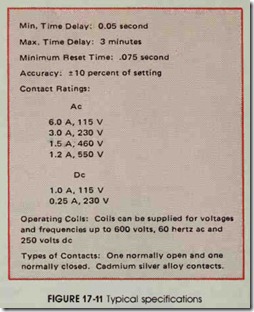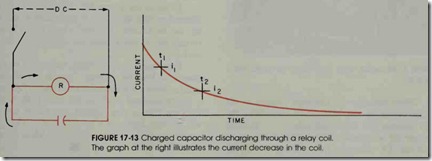After studying this unit, the student will be able to:
• Identify the primary types of timing relays
• Explain the basic steps in the operation of the common timing relays
• List the factors that affect the selection of a timing relay for a particular use
• List applications of several types of timing relays
• Draw simple circuit diagrams using timing relays
• Identify on- and off-delay timing wiring symbols
Time delay relays can be divided into two general classifications: the on-delay relay, and the off-delay relay. The on-delay relay is often re ferred to as DOE which stands for “Delay On En ergize.” The off-delay relay is often referred to as DODE which stands for “Delay On De-Ener gize.”
Timer relays are similar to other control re lays in that they use a coil to control the operation of some number of contacts. The difference be tween a control relay and a timer relay is that the contacts of the timer relay delay changing their position when the coil is energized or de-ener gized. When power is connected to the coil of an on-delay timer, the contacts delay changing posi tion for some period of time. For this example as sume that the timer has been set for a delay of 10 seconds. Also assume that the contact is normally open. When voltage is connected to the coil of the on-delay timer, the contacts will remain in the open position for 10 seconds and then close. When voltage is removed and the coil is de-energized, the contact will immediately change back to its normally open position. The contact symbols for an on-delay relay are shown in figure 17-1.
The operation of the off-delay timer is the op posite of the operation of the on-delay timer. For this example, again assume that the timer has been set for a delay of 10 seconds, and also assume that the contact is normally open. When voltage is ap plied to the coil of the off-delay timer, the contact will change immediately from open to closed. When the coil is de-energized, however, the con tact will remain in the closed position for 10 sec onds before it reopens. The contact symbols for an off-delay relay are shown in figure 17-2. Time delay relays can have normally open, normally closed, or a combination of normally open and normally closed contacts.
Although the contact symbols shown in fig ures 17-1 and 17-2 are standard NEMA symbols for on-delay and off-delay contacts, some control schematics may use a different method of indicat ing timed contacts. The abbreviations TO and TC are used with some control schematics to indicate a time-operated contact. TO stands for time open ing, and TC stands for time closing. If these abbre viations are used with standard contact symbols, their meaning can be confusing. Figure 17-3 shows a standard normally open contact symbol with the abbreviation TC written beneath it. This contact must be connected to an on-delay relay if it is to be time delayed when closing. Figure 17-4 shows the same contact with the abbreviation TO beneath it. If this contact is to be time delayed when opening, it must be operated by an off-delay timer. These abbreviations can also be used with standard NEMA symbols as shown in figure 17-5.
DASHPOT TIMERS
Although timers are divided into two basic classifications, the on-delay and the off-delay, sev eral methods are used to obtain these time delays. One of these is the dashpot timer shown in figure 17-6. This timer operates by forcing a fluid to flow through orifices in a piston. The operation of a dashpot timer is the same as the operation of the dashpot overload discussed in Unit 13. The only real difference between the dashpot timer and the dashpot overload relay is the type of coil used. The dashpot timer uses a voltage operated coil and the dashpot overload relay uses a current operated coil.
PNEUMATIC TIMERS
Pneumatic, or air timers, operate by restrict ing the flow of air through an orifice to a rubber bellows or diaphragm. Figure 17-7 illustrates the principle of operation of a simple bellows timer. If rod “A” pushes against the end of the bellows, air is forced out of the bellows through the check valve as the bellows contracts. When the bellows is moved back, contact TR changes from an open to a closed contact. When rod “A” is pulled away from the bellows, the spring tries to return the bellows to its original position. Before the bellows can be returned to its original position, however, air must enter the bellows through the air inlet port. The rate at which the air is permitted to en ter the bellows is controlled by the needle valve. When the bellows returns to its original position, contact TR returns to its normally open position.
Pneumatic timers are popular throughout in dustry because they have the following character istics:
A. They are unaffected by variations in am bient temperature or atmospheric pressure.
B. They are adjustable over a wide range of time periods.
C. They have good repeat accuracy.
D. They are available with a variety of contact and timing arrangements.
Some pneumatic timers are designed to permit the timer to be changed from on-delay to off-delay, and the contact arrangement to be changed to nor mally opened or normally closed, figure 17-8. This type of flexibility is another reason for the popu larity of pneumatic timers.
Many timers are made with contacts that op erate with the coil as well as time delayed contacts. When these contacts are used, they are generally referred to as instantaneous contacts and indicated on a schematic diagram by the abbreviation, inst., printed below the contact, figure 17-9. These in stantaneous contacts change their positions imme diately when the coil is energized and change back to their normal positions immediately when the coil is de-energized.
CLOCK TIMERS
Another ti er frequently used is the clock timer, figure 17-10. Clock timers use a small ac synchronous motor similar to the motor found in a wall clock to provide the time measurement for the timer. The length of time of one clock timer may vary greatly from the length of time of an other. For example, one timer may have a full range of 0 to 5 seconds and another timer may have a full range of 0 to 5 hours. The same type of timer motor could be used with both timers. The gear ratio connected to the motor would de termine the full range of time for the timer. Some advantages of clock timers are:
A. They have extremely high repeat accuracy.
Readjustment of the time setting is simple and can be done quickly. Clock timers are generally used when the machine operator must make adjustments of the time length.
MOTOR-DRIVEN TIMERS
When a process has a definite on and off op eration, or a sequence of successive operations, a motor-driven timer is generally used, figures 17-11 and 17-12. A typical application of a motor-driven timer is to control laundry washers where the loaded motor is run for a given period in one di rection, reversed, and then run in the opposite di rection.
Generally, this type of timer consists of a small, synchronous motor driving a cam-dial as sembly on a common shaft. A motor-driven timer successively closes and opens switch contacts which are wired in circuits to energize control re lays or contactors to achieve desired operations.
CAPACITOR TIME LIMIT RELAY
Assume that a capacitor is charged by con necting it momentarily across a de line and then the capacitor direct current is discharged through a relay coil. The current induced in the coil will decay slowly, depending on the relative values of capacitance, inductance, and resistance in the dis charge circuit.
If a relay coil and a capacitor are connected parallel to a de line, figure 17-13, the capacitor is charged to the value of the line voltage and a cur rent appears in the coil. If the coil and capacitor combination is now removed from the line, the current in the coil will start to decrease along the curve shown in figure 17-13.
If the relay is adjusted so that the armature is released at current ib a time delay of t 1 is ob tained. The time delay can be increased to a value of t2 by adjusting the relay so that the armature will not be released until the current is reduced to a value of i2 • Figure 17-14 shows a relay used for this type of time control.
A potentiometer is used as an adjustable resis tor to vary the time. This resistance-capacitance (RC) theory is used in industrial electronic and solid-state controls also. This timer is highly ac curate and is used in motor acceleration control and in many industrial processes.
ELECTRONIC TIMERS
Electronic timers use solid-state components to provide the time delay desired. Some of these timers use an RC time constant to obtain the time base and others use quartz clocks as the time base, figure 17-15. RC time constants are inexpensive and have good repeat times. The quartz timers, however, are extremely accurate and can often be set for .1 second times. These timers are generally housed in a plastic case and are designed to be plugged into some type of socket. An electronic timer that is designed to be plugged into a stan dard eight-pin tube socket is shown in figure 17-16. The length of the time delay can be set by adjusting the control knob shown on top of the timer.
The schematic for a simple on-delay timer is
shown in figure 17-17. The timer operates as fol lows: When switch S1 is closed, current flows through resistor RT and begins charging capacitor Cl. When capacitor C1 has been charged to the trigger value of the unijunction transistor, the UJT turns on and discharges capacitor C1 through resistor R2 to ground. The sudden discharge of capacitor C1 causes a spike voltage to appear across resistor R2. This voltage spike travels through capacitor C2 and fires the gate of the SCR. When the SCR turns on, current is provided to the coil of relay Kl.
Resistor R1 limits the current flow through the UJT. Resistor R3 is used to keep the SCR turned off until the UJT provides the pulse to fire the gate. Diode D1 is used to protect the circuit from the spike voltage produced by the collapsing magnetic field around coil K 1 when the current is turned off.
By adjusting resistor RT, capacitor C1 can be charged at different rates. In this manner, the re lay can be adjusted for time. Once the SCR has turned on, it will remain on until switch S1 is opened.
Programmable controllers, which will be dis cussed in Unit 64, contain “internal” electronic timers. Most programmable controllers (PCs) use a quartz-operated clock as the time base. When the controller is programmed, the timers can be set in time increments of .1 second. This, of course, provides very accurate time delays for the controller.
REVIEW QUESTIONS
1. What are the two basic classifications of timers?
2. Explain the operation of an on-delay relay.
3. Explain the operation of an off-delay relay.
4. What are instantaneous contacts?
5. Dashpot timers differ from dashpot overloads in that the timer has a _
operated coil and the overload has a operated coil.
6. How are pneumatic timers adjusted?
7. Name two methods used by electronic timers to obtain their time base.
